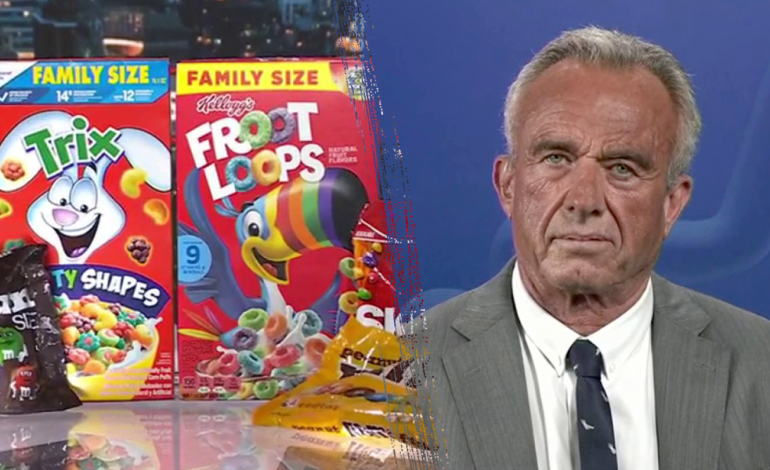In some countries, food manufacturers have already made the switch to natural colorings in popular products, leaving behind the artificial dyes commonly used in the US However, despite growing calls for change, it remains uncertain when or if major American food companies will follow suit.
Take Froot Loops, for example. A box of the iconic cereal sold in the US contains a bright array of colors — red, orange, green, purple, yellow, and blue — all derived from synthetic dyes such as Red No. 40, Yellow No. 5, and Blue No. 1. Yet, the same product sold in Canada uses natural alternatives, drawing colors from blueberry juice, watermelon, and huito, an Amazonian fruit. Despite this difference, the manufacturer, WK Kellogg, could easily replicate the change in the US, raising the question: Will they, or other major food companies, shift to these natural methods in response to consumer demand?
Robert F. Kennedy Jr., the US Secretary of the Department of Health and Human Services, has been outspoken about the dangers of synthetic dyes and their potential link to health issues. He has long criticized the use of petroleum-based dyes in foods like Froot Loops, arguing that they contribute to poor health outcomes. Recently, Kennedy announced an “understanding” with major food manufacturers to eliminate synthetic food colorings from products by 2026. However, the meaning of this “understanding” remains vague, as no companies were present at his announcement, and many have not publicly committed to removing the dyes.
Despite this, some companies are beginning to take steps toward eliminating synthetic colors. PepsiCo, for instance, announced plans to either phase out synthetic colors or offer natural alternatives in the coming years. This marks a shift toward meeting growing consumer demand for more natural products, a trend that started years ago. Notably, Kraft Macaroni & Cheese managed to replace its signature orange color with natural ingredients like turmeric and paprika. However, not all companies have embraced the change, with some returning to synthetic dyes when sales of natural-colored products did not meet expectations.
Critics, however, argue that voluntary changes within the food industry are insufficient. Dr. Peter Lurie, former FDA official and head of the Center for Science in the Public Interest, warned that relying on industry compliance has proven to be ineffective in the past. He called for stronger government action to eliminate artificial dyes from the food supply.
Making the switch to natural dyes, however, presents significant challenges. James Herrmann, the director of food colors at Sensient Technologies, explained that developing natural alternatives requires more time and effort. Growing the necessary plants, extracting the colors, and ensuring consistency across products can take up to two years. Moreover, natural colors are more sensitive to heat and light and have a shorter shelf life, posing logistical challenges for food manufacturers. Natural dyes also tend to be less stable and may require adjustments in production processes, including new equipment and storage systems. Additionally, the use of natural ingredients often requires larger quantities, which could increase costs and lead to reformulation of recipes.
Even as demand for natural colorants grows, the availability of raw materials like carrots, beets, and spirulina may not meet the demands of food manufacturers, according to Herrmann. Furthermore, replacing synthetic colors with natural ones could drive up production costs, which would likely be passed on to consumers.
While synthetic dyes have been a staple in the US food industry, health concerns surrounding them are growing. In 2021, a report from the State of California suggested that synthetic food dyes were linked to hyperactivity and other behavioral issues in children. This concern has led to legislative actions, including California’s ban on artificial dyes in school meals, and other states are beginning to consider similar measures.
In the face of growing health concerns and mounting pressure, some food companies have already taken steps toward removing synthetic dyes. WK Kellogg, for example, has removed artificial colors from cereals sold in schools and is exploring ways to eliminate them from other products. Despite these efforts, the shift to natural colors is expected to take time. It is not simply a matter of replacing synthetic dyes with natural alternatives; the entire production process must be adjusted, which could be a complex and expensive endeavor.
The growing movement to remove synthetic food dyes aligns with broader consumer trends toward healthier, more natural products. However, whether this shift will occur swiftly in the US remains uncertain. With companies like PepsiCo and Kraft leading the way, there is a glimmer of hope that other major food manufacturers will follow suit, but it may take time for these changes to become widespread.
The New York Times and FOX News contributed to this report.










The latest news in your social feeds
Subscribe to our social media platforms to stay tuned